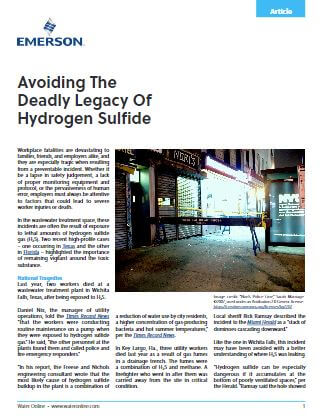Deadly hydrogen sulfide (H₂S) can be present in industries such as oil & gas production and wastewater treatment. The Wikipedia Hydrogen Sulfide page highlights the danger:
Short-term, high-level exposure can induce immediate collapse, with loss of breathing and a high probability of death. If death does not occur, high exposure to hydrogen sulfide can lead to cortical pseudolaminar necrosis, degeneration of the basal ganglia and cerebral edema.[31] Although respiratory paralysis may be immediate, it can also be delayed up to 72 hours.[38]
 In a Water Online article, Avoiding The Deadly Legacy Of Hydrogen Sulfide, Emerson’s Sean McLeskey is quoted:
In a Water Online article, Avoiding The Deadly Legacy Of Hydrogen Sulfide, Emerson’s Sean McLeskey is quoted:
“H₂S gas is naturally present and produced in wastewater treatment… It is found in raw sewage and throughout sludge processing stages, so it’s critical to monitor for the gas in sewers, sludge de-watering systems, anaerobic digesters, and wet/dry wells.”
As Sean indicates, continuous monitoring for H₂S is critical for personnel safety. Solutions:
…like Emerson’s Millennium II Series of universal fixed gas detection transmitters, combined with its range of toxic and combustible gas sensors, can be applied to combat the threat of leaking H₂S.
Advancements in technology and communications standards have enabled the development of wireless gas monitoring sensors. One example is:
…the Rosemount 928 Wireless Gas Monitor [hyperlink added]. In some plants, it can be cost prohibitive to install and operate conventional gas detection systems at these sites due to geography and infrastructure. The installation, wiring, and commissioning costs for each additional wired device can add tens of thousands of dollars to the instrument’s total installed cost.
Read the article for more on these technologies improve personnel safety and how these technologies work. Visit the Wireless Gas Detectors and Sensors section of Emerson.com for more on the technologies and applications.
You can also connect and interact with other gas monitoring experts in the Measurement Instrumentation group in the Emerson Exchange 365 community.





